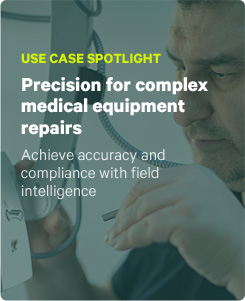
This is a guest post by Bryna Moloughney, Strategic Account Manager, with ProntoForms.
We have all been guilty of taking for granted something which others view as “unique,” “special,” or “vitally important.” For me, this has been the offline mobile user experience.
Until recently, this was not something I saw as especially important or adding much value. But then a colleague challenged that assumption. He told me that offline capabilities are one of the key criteria for businesses evaluating enterprise mobile apps. My initial reaction to this was, “Isn’t offline mode a given for mobile?” Turns out, it wasn’t. Over the course of the next several weeks, I started to hear from both prospects and clients who wanted to know, “Does your app work offline?”
Instead of providing my standard answer – “Yes, the app works offline” – I dug deeper into the question. What I uncovered was not so common-place; in fact, what I learned is that their offline needs weren’t simple at all.
According to Gartner, the average enterprise has deployed eight apps, 2.6 in development, and 6.2 planned for the next 12 months. In the US alone, employees access on average 5.2business apps a day, and that number is expected to grow significantly. Given this projected growth in the Enterprise Mobile App space, and businesses’ reliance on mobility, offline capabilities are becoming increasingly necessary. Unlike consumer apps, the Enterprise Mobile App provides business-critical tools to the users in the field. Without offline capabilities a user could potentially find themselves in a position where they wouldn’t be able to do their job.
At this point, you are most likely thinking, “Isn’t that a given?” And you would be right, but let’s explore the nuances of what companies are actually looking for.
In my previous blog, 3 Key Trends in Field Service Management, I spoke about context with regards to process standardization and data collection. Offline mode is a huge part of contextual business processes, carrying with it the required data from one or multiple back-end systems to enable the end user with all necessary tools and data to complete their tasks. This multi-system, cross-departmental data is generally siloed and only available in its native app, therefore providing very little context or support to the end user as they move through their day-to-day activities.
A Common Case for Offline
John is an FSE for a medical device company, and he has been dispatched a work order to perform preventative maintenance on a CT scanner at a local hospital. He reviews the details of the work order online before he heads out for the day. Once in his vehicle, he pulls up his first app to track his travel time, then opens Google Maps to navigate to the hospital. At the hospital, he opens the time-tracking app again and finalizes his entry. Out of his truck, he opens a 3rdapp to review the work order again and then pulls from his truck the right tools and parts he thinks he will need to complete the job. At which point a 4thapp containing ERP data is required. Now in the hospital, he calls the site contact to notify them he has arrived, so a 5thapp with relevant CRM data is opened. 5 apps later, he’s finally ready to do his job.
Down in the belly of the hospital, there is no connectivity. Before he can touch the equipment, he needs to do a standard safety check. This will be the 6thapp he utilizes, but he will do so for the first time offline. And this is where his already cumbersome experience gets worse. Although the HSE app he’s using works offline, it does not have any CRM data, asset information, or working environment details that are needed to do the safety check. This app has no context, which means John needs to enter this information into the system manually. As a result, John spends an additional 10 minutes on this task, reducing his overall productivity. And despite his best efforts, he missed a required section specific to this CT scanner putting John, the hospital, and his company at serious risk.
This scenario is repeated as he works through his PM tasks in a fillable PDF. The app works offline, but has no context of the customer, no historical service information, no data on the specific asset or parts. This results in more lost time, increased data entry errors, and related compliance risks.
When a customer asks, “Does your app work offline?” they’re really asking, “Can your platform help me transform the way our people currently do their jobs?”, “Can you make their lives easier?”, “Can you help my business find a better way to realize the promised benefits found in digitizing our process?”, because what they’re doing isn’t working. It’s a simple question, one they are asking out of fear, based on past experiences and hard lessons learned. The question they are really asking is: Can you make life simpler for my company and my people?
Businesses Need Contextual Offline Capabilities
At ProntoForms, we’re sometimes guilty of undervaluing our offline capabilities, and of not fully appreciating the true value we offer our clients. We’re enabling them to provide context to their users, whether online or off, and in doing so helping them reduce the number of apps needed so that people can simply do their job.
Experts predict that the global enterprise mobility market will be worth as much as $140 billion by 2020, yet nearly 80% of enterprise mobile apps are abandoned after their first use due in large part because 64% of employees have a poor user experience. I challenge you and your organization to step back and look at the elements of your digital transformation strategy and how your current mobile apps stack up in providing context to your users, online and off.
If you want to see how contextual offline mobile apps can help your business, contact us for a demo.




